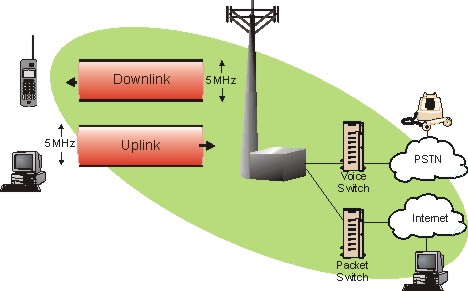A term commonly used to describe the third generation of technology used in a specific application or industry. In cellular telecommunications, third generation systems used wideband digital radio technology as compared to 2nd generation narrowband digital radio. For third generation cordless telephones, products used multiple digital radio channels and new registration processes allowed some 3rd generation cordless phones to roam into other public places.
This diagram shows a 4th generation broadband wireless system. This system uses two 5 MHz wide radio channels to provide for simultaneous (duplex) transmission between the end-user and other telecommunication networks. There are different channels used for end- user to the system (called the "uplink") and from the system to the end-user (called the "downlink"). This diagram shows that 4G networks interconnect with the public switched telephone network and the Internet. While the radio channel is divided into separate codes, different protocols are used on the radio channels to give high priority for voice information and high-integrity to the transmission of data information.
